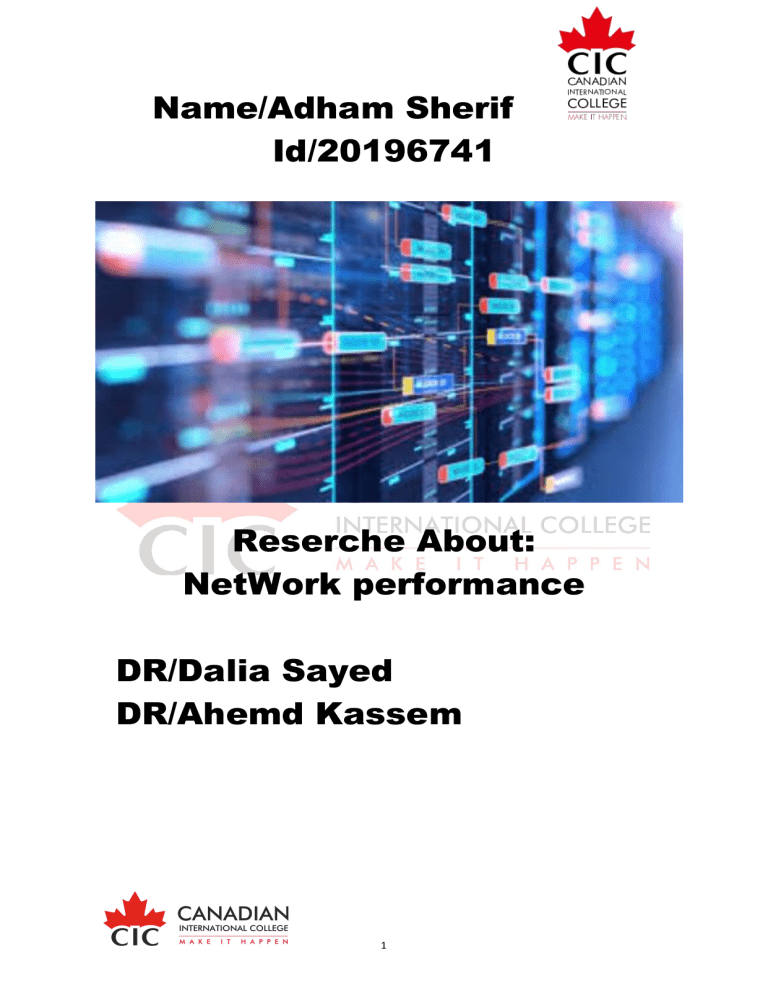
Name/Adham Sherif Id/20196741 Reserche About: NetWork performance DR/Dalia Sayed DR/Ahemd Kassem 1 Introduction any modern networking applications can benefit from improved Quality of Service (QoS) supported across multiple administrative domains. GÉANT2, the Gigabit core pan-European research network, for example, supports Premium IP service to the European National Research & Education Networks (NRENs). Provisioning of end-to-end advanced transport services requires methods for verifying the established Service Level Agreements (SLAs) between the service provider and its customers. Even in a well-engineered network, however, occasional equipment failure or misconfiguration can cause severe degradation of service performance 2 GN2-JRA1 Monitoring Architecture (perfSONAR) The perfSONAR system is a framework that enables information about network performance to be gathered and exchanged in a multi-domain, federated manner.ThegoaofperfSONARistoenablethe ubiquitous gathering and sharing of this performance information in order to ease the managementofadvancednetworks,tofacile cross-domain troubleshooting and to allow next-generation applications to tailor their execution to the state of the network. This system has been designed to accommodate easy extensibility for new networkmetricsandto facilitate the automatic processing of these metrics as much as possible. The perfSONAR architecture is composed of three different layers, as shown in Figure 1. The Measurement Point Layer is responsible for performing active or passive measurement tests via multiple Measurement Points 3 (MPs), i.e., existing network monitoring tools. The MP is wrapped into a higher-level abstraction called Measurement Point Service, belonging to the Service Layer, which hides the implementation details of the MP. The Service Layer is composed of multiple services that control the monitoring infrastructure to receive, store and exchange measurement and network topology data. Services interact with each other without human intervention (e.g., measurement data retrieved by a Measurement Point Service is fed into a Measurement Archive Service and manipulated by a Transformation Service) and with the upper User Interface Layer. The end users interact via the visualisation tools at the User Interface Layer only. The whole architecture is based on Web Services (WS) technology, which allows the definition of the interaction between services through well-defined, language-independent interfaces. Web Services are closely tied to the 4 eXtensible Markup Language (XML). The perfSONAR system uses and extends a schema defined by the Global Network Metric Composition (Transformation Service) Unfortunately, establishing a common understanding of network metric definitions, their measurement methodologies and their accuracy is not enough. In general, network measurements need to be post-processed (composed) to be useful for the various tasks of network engineering, management and planning. This becomes fundamental in a multi-domain environment such as the one targeted by perfSONAR. There are several reasons for composing network metrics: The first one is data reduction. Consider, for example, a network domain in which delay measurements are performed on all links. A network manager might ask 5 whether there is a general problem with the network delay. Therefore, it would be desirable to obtain a single summary value calculated from the delay measurements on a single domain’s links. We call this composition “aggregation in space”. In the example in Figure 2, a weight, proportional to the traffic carried on the links is applied, to produce a summary OWD value for this single domain. Other rules to produce a summary value may be used; for example, a service provider that offers Service Level Agreements (SLAs) to his/her customers might prefer to estimate the maximum value of the average OWD between any edge points in its network. As shown in Table 1, aggregation in space can potentially be performed with a large group of performance metrics. However, the specific operation on the collected data sets depends on the usage of the results. Another important reason for composing network metrics is to perform trend analysis. For doing so, a single 6 value for an hour, a day or a month is computed from the basic measurements which are scheduled with finer granularity, e.g., every five minutes (see Figure 2). In this way, trends can be more easily observed, like an increasing usage of a backbone link which might require the installation of alternative links or the rerouting of some network flows. This type of composition is called “aggregation in time”. This method reduces the amount of data at the expense of data time resolution. Aggregation in time is widely used by visualisation tools, such as MRTG [10], that present various parameters of network performance in different time-scales. Aggregation in time is fundamental in estimating packet loss in a link using active measurements; since packet losses are usually quite rare, only the time aggregation of several different experiments may be meaningful. Finally, composition may be performed for scalability. Due to the number of network elements in large networks 7 like GÉANT2 and the connected NRENs, it is impossible to perform a full mesh of measurements between all the equipment, either regularly or on demand. However, if regular measurements are scheduled between selected Measurement Point pairs, say, A to B and B to C, we can try to infer the value of a network performance metric (e.g., the OWD) on a path, say, A to C, even in the absence of a direct measurement between the end points of that path. This type of composition is called “concatenation in space” (see Figure 2 8 9

